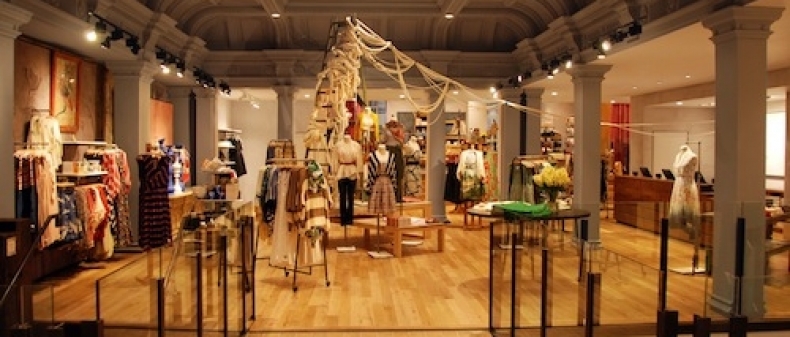
At the Interior Design Show this past weekend, Aaron Hoey made his second appearance in Toronto. The first was three months ago, when he came here to seek out local artists and artisans whose products Anthropologie might sell or commission. That’s his job, or at least the fun part of it: he spends 40% of his year prospecting for new, handcrafted objects in cities and villages. The other 60% he spends turning them into products, to satisfy the pretty-bourgeoisie whims of Anthro’s devoted clientele.
What prepared you for this new, global role at Anthropologie?
As part of my experience professionally, I worked for GAP for 14 years, and those were the golden years of working there. It was a highly creative environment. So I’d had experiences working on a large scale by running GAP Mens, and also doing small projects, like Project (RED). That gave me a lot of great experience, and now my personal passion for art has come into play.
And craft, as well. I think Anthropologie is associated more with that crafty, sweet, sentimental, um, domestic-goddessy thing, or at least that’s how I think of it.
Domestic-goddessy. I might quote you!
And so you’re introducing more one-of-a-kind things and working with artisans in different places. How do you choose from–I mean, that marketplace is so massive now, even to sit on Etsy for 20 minutes is to be overwhelmed. What’s the criteria? How do you know when it’s right for Anthro?
You know, in a lot of ways, I say this a lot, but it’s like dating. How do you know when you’re attracted to somebody and you just fall in love? It’s the same thing with product. I mean, if you have a clear vision of what you’re trying to execute, then it’s really easy in your head to pull things in and say that’s right, that’s right in the mix. It comes down to timing and balance. We might see something that’s really good but we have too much of that thing happening. So you have to make it what we call a lady-in-waiting and you pause on it. Because we, what we have to do, and you talked about that sentimental side of the company, but everything can’t be that. You have to balance femininity with preppy with bohemian. They all have to come into play. You almost have a shopping list in your head. But then there’s something fresh and new, and it just turns you on.
To what extent is that shopping list determined by trends?
You have to be aware of trends, for sure. But it doesn’t drive what we do. The most important thing in trends is colour, but for us it’s about experimentation and exploration. We like to zig when everyone else is zagging. If the movement is contemporary, then we’ll play off of that sweet, crafty nature. I think where we’ve carved out a space is in doing something unique and sometimes ignoring trends.
How does it work when you collaborate with artists? I understand that sometimes you buy the pieces readymade, and sometimes you commission custom objects. How do you decide what to do, and how do they get paid?
It depends on who they are. In some cases, the object that the artist or artisan is making is perfect, and we just buy it upfront at the rate they’re selling it, whether it’s on Etsy–although we don’t like to use Etsy very much, because anyone can see it online–or in a village. If we’re collaborating, like in a Sam Robinson kind of scenario, we either pay her to make it or buy the designs and manufacture it for her. It’s really decided on a case-by-case basis.
What about store by store?
Yes, definitely, we love to localize. So if you have a great ceramicist in Toronto and he or she can only make a couple hundred units–because a lot of people aren’t set up to manufacture–well, that’s great, because we’ll send them to five stores. We’ll see them in Toronto, of course, and we’ll also shoot some to California, where this artisan wouldn’t have naturally been exposed.
Where are some of the more interesting places, in terms of the local art/artisan scene, that you’ve visited recently?
I think South America. There’s Cusco in Peru, and there’s Lima, of course, a very cosmopolitan city, wonderful food. Being in Bahia in Brazil was pretty amazing. South America’s a very interesting place because it’s so vast and huge and full of cultures. It’s right here in the Western hemisphere, and most of the time it’s on the same time zone, but most North Americans have never been.
Is it difficult to communicate to craftspeople who, I’m assuming, don’t know what Anthropologie is?
No, I mean, outside of the United States we’re very little known. So we have to represent ourselves and introduce ourselves. A lot of times I bring catalogues with me, and then they think we’re a catalogue company, but I’m like no, no, no, we have all these stores. It’s definitely a long conversation to get people to understand what we’re trying to accomplish.
And what are you trying to accomplish? Give me the pitch. Pretend I’m Australian or something.
The pitch is, you’re an artist, you’re wildly talented, but not a lot of people have seen your work. We’d love to expand on your work and give you some exposure you wouldn’t get anywhere else. We’re about craft and one-of-a-kind things and we’d love to collaborate you, whether it’s by buying your products or buying your designs. And you can tell us how you’d love to see us use those designs.
I thiiiink I’m sold. It’s good that Anthropologie does this. But at the same time, some of the practices of your sister company, Urban Outfitters, have come under fire. So while Anthropologie is working with global artisans and promoting them, Urban Outfitters is seemingly doing the opposite, just ripping off these poor kids in Oregon.
We operate like a mom-and-pop at Anthropologie. We actually know nothing about Urban Outfitters. I don’t know a single person that works there. While it is a sister company because it’s owned by the same parent company, we don’t know what goes on there. I would encourage them, if they’ve done any of these things, to clean up their act. I don’t want our reputation damaged by anything that’s happened in the past at Urban; it’s not what the CEO wants, either. For me, it’s a lesson: I’ll never let that happen at Anthropologie.














